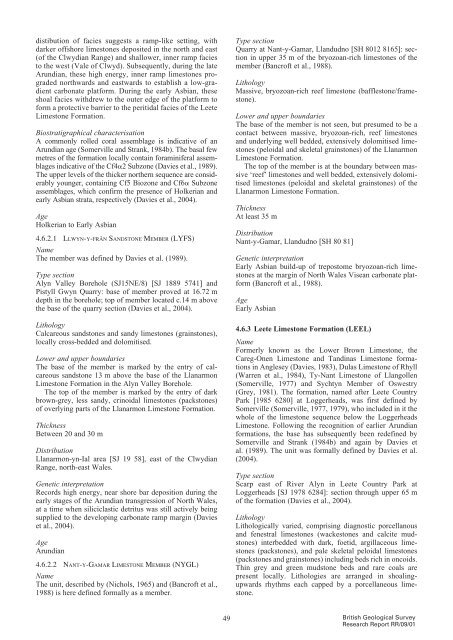A lithostratigraphical framework for the Carboniferous successions ...
A lithostratigraphical framework for the Carboniferous successions ...
A lithostratigraphical framework for the Carboniferous successions ...
Create successful ePaper yourself
Turn your PDF publications into a flip-book with our unique Google optimized e-Paper software.
distibution of facies suggests a ramp-like setting, with<br />
darker offshore limestones deposited in <strong>the</strong> north and east<br />
(of <strong>the</strong> Clwydian Range) and shallower, inner ramp facies<br />
to <strong>the</strong> west (Vale of Clwyd). Subsequently, during <strong>the</strong> late<br />
Arundian, <strong>the</strong>se high energy, inner ramp limestones prograded<br />
northwards and eastwards to establish a low-gradient<br />
carbonate plat<strong>for</strong>m. During <strong>the</strong> early Asbian, <strong>the</strong>se<br />
shoal facies withdrew to <strong>the</strong> outer edge of <strong>the</strong> plat<strong>for</strong>m to<br />
<strong>for</strong>m a protective barrier to <strong>the</strong> peritidal facies of <strong>the</strong> Leete<br />
Limestone Formation.<br />
Biostratigraphical characterisation<br />
A commonly rolled coral assemblage is indicative of an<br />
Arundian age (Somerville and Strank, 1984b). The basal few<br />
metres of <strong>the</strong> <strong>for</strong>mation locally contain <strong>for</strong>aminiferal assemblages<br />
indicative of <strong>the</strong> Cf4�2 Subzone (Davies et al., 1989).<br />
The upper levels of <strong>the</strong> thicker nor<strong>the</strong>rn sequence are considerably<br />
younger, containing Cf5 Biozone and Cf6� Subzone<br />
assemblages, which confirm <strong>the</strong> presence of Holkerian and<br />
early Asbian strata, respectively (Davies et al., 2004).<br />
Age<br />
Holkerian to Early Asbian<br />
4.6.2.1 llWyN-y-frâN saNDstoNe memBer (lyfs)<br />
Name<br />
The member was defined by Davies et al. (1989).<br />
Type section<br />
Alyn Valley Borehole (SJ15NE/8) [SJ 1889 5741] and<br />
Pistyll Gwyn Quarry: base of member proved at 16.72 m<br />
depth in <strong>the</strong> borehole; top of member located c.14 m above<br />
<strong>the</strong> base of <strong>the</strong> quarry section (Davies et al., 2004).<br />
Lithology<br />
Calcareous sandstones and sandy limestones (grainstones),<br />
locally cross-bedded and dolomitised.<br />
Lower and upper boundaries<br />
The base of <strong>the</strong> member is marked by <strong>the</strong> entry of calcareous<br />
sandstone 13 m above <strong>the</strong> base of <strong>the</strong> Llanarmon<br />
Limestone Formation in <strong>the</strong> Alyn Valley Borehole.<br />
The top of <strong>the</strong> member is marked by <strong>the</strong> entry of dark<br />
brown-grey, less sandy, crinoidal limestones (packstones)<br />
of overlying parts of <strong>the</strong> Llanarmon Limestone Formation.<br />
Thickness<br />
Between 20 and 30 m<br />
Distribution<br />
Llanarmon-yn-Ial area [SJ 19 58], east of <strong>the</strong> Clwydian<br />
Range, north-east Wales.<br />
Genetic interpretation<br />
Records high energy, near shore bar deposition during <strong>the</strong><br />
early stages of <strong>the</strong> Arundian transgression of North Wales,<br />
at a time when siliciclastic detritus was still actively being<br />
supplied to <strong>the</strong> developing carbonate ramp margin (Davies<br />
et al., 2004).<br />
Age<br />
Arundian<br />
4.6.2.2 NaNt-y-gamar limestoNe memBer (Nygl)<br />
Name<br />
The unit, described by (Nichols, 1965) and (Bancroft et al.,<br />
1988) is here defined <strong>for</strong>mally as a member.<br />
49<br />
Type section<br />
Quarry at Nant-y-Gamar, Llandudno [SH 8012 8165]: section<br />
in upper 35 m of <strong>the</strong> bryozoan-rich limestones of <strong>the</strong><br />
member (Bancroft et al., 1988).<br />
Lithology<br />
Massive, bryozoan-rich reef limestone (bafflestone/framestone).<br />
Lower and upper boundaries<br />
The base of <strong>the</strong> member is not seen, but presumed to be a<br />
contact between massive, bryozoan-rich, reef limestones<br />
and underlying well bedded, extensively dolomitised limestones<br />
(peloidal and skeletal grainstones) of <strong>the</strong> Llanarmon<br />
Limestone Formation.<br />
The top of <strong>the</strong> member is at <strong>the</strong> boundary between massive<br />
‘reef’ limestones and well bedded, extensively dolomitised<br />
limestones (peloidal and skeletal grainstones) of <strong>the</strong><br />
Llanarmon Limestone Formation.<br />
Thickness<br />
At least 35 m<br />
Distribution<br />
Nant-y-Gamar, Llandudno [SH 80 81]<br />
Genetic interpretation<br />
Early Asbian build-up of trepostome bryozoan-rich limestones<br />
at <strong>the</strong> margin of North Wales Visean carbonate plat<strong>for</strong>m<br />
(Bancroft et al., 1988).<br />
Age<br />
Early Asbian<br />
4.6.3 Leete Limestone Formation (LEEL)<br />
Name<br />
Formerly known as <strong>the</strong> Lower Brown Limestone, <strong>the</strong><br />
Careg-Onen Limestone and Tandinas Limestone <strong>for</strong>mations<br />
in Anglesey (Davies, 1983), Dulas Limestone of Rhyll<br />
(Warren et al., 1984), Ty-Nant Limestone of Llangollen<br />
(Somerville, 1977) and Sychtyn Member of Oswestry<br />
(Grey, 1981). The <strong>for</strong>mation, named after Leete Country<br />
Park [1985 6280] at Loggerheads, was first defined by<br />
Somerville (Somerville, 1977, 1979), who included in it <strong>the</strong><br />
whole of <strong>the</strong> limestone sequence below <strong>the</strong> Loggerheads<br />
Limestone. Following <strong>the</strong> recognition of earlier Arundian<br />
<strong>for</strong>mations, <strong>the</strong> base has subsequently been redefined by<br />
Somerville and Strank (1984b) and again by Davies et<br />
al. (1989). The unit was <strong>for</strong>mally defined by Davies et al.<br />
(2004).<br />
Type section<br />
Scarp east of River Alyn in Leete Country Park at<br />
Loggerheads [SJ 1978 6284]: section through upper 65 m<br />
of <strong>the</strong> <strong>for</strong>mation (Davies et al., 2004).<br />
Lithology<br />
Lithologically varied, comprising diagnostic porcellanous<br />
and fenestral limestones (wackestones and calcite mudstones)<br />
interbedded with dark, foetid, argillaceous limestones<br />
(packstones), and pale skeletal peloidal limestones<br />
(packstones and grainstones) including beds rich in oncoids.<br />
Thin grey and green mudstone beds and rare coals are<br />
present locally. Lithologies are arranged in shoalingupwards<br />
rhythms each capped by a porcellaneous limestone.<br />
British Geological Survey<br />
Research Report RR/09/01

















